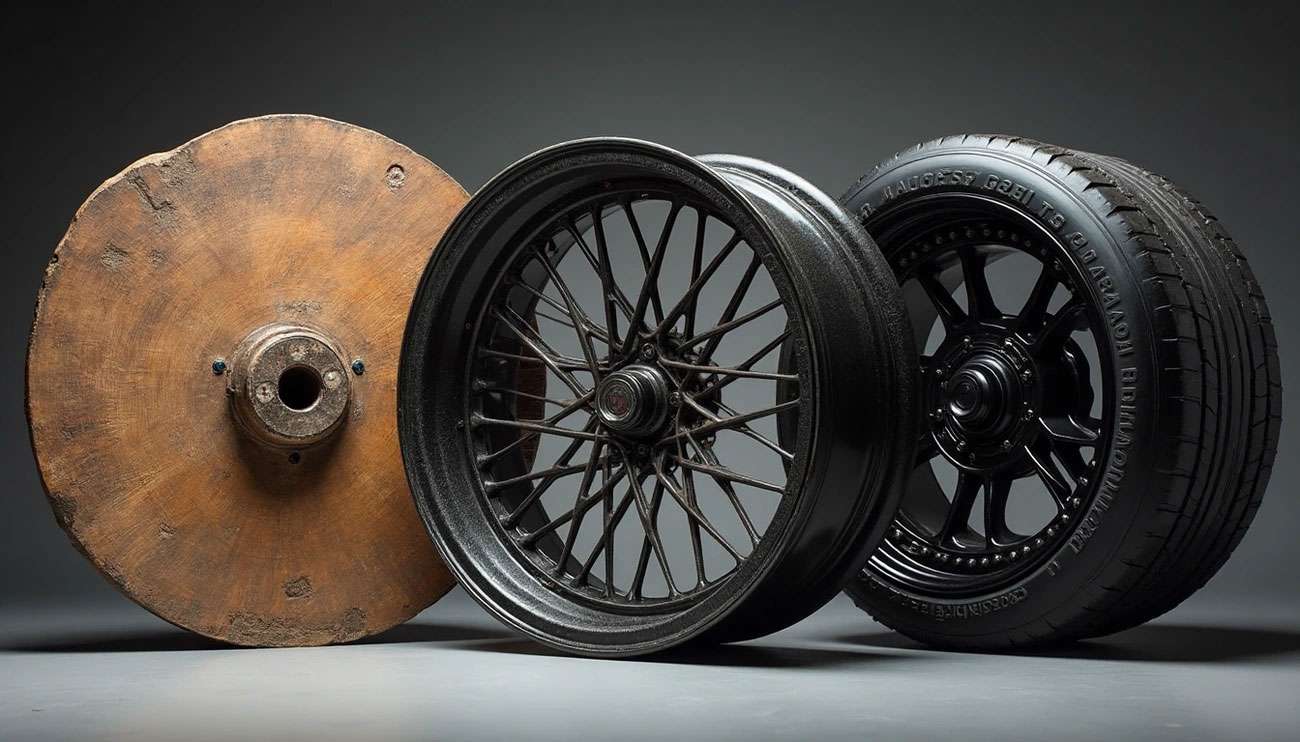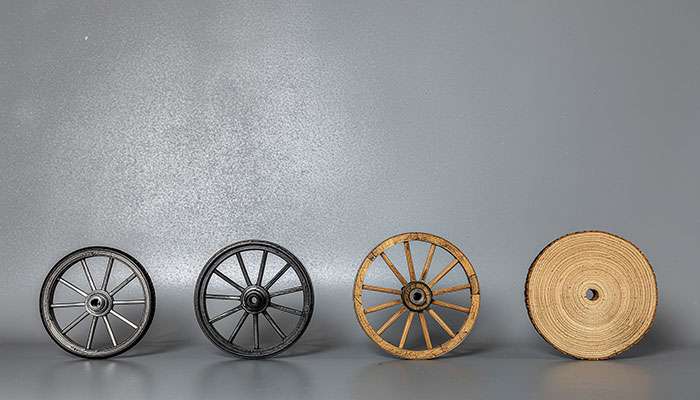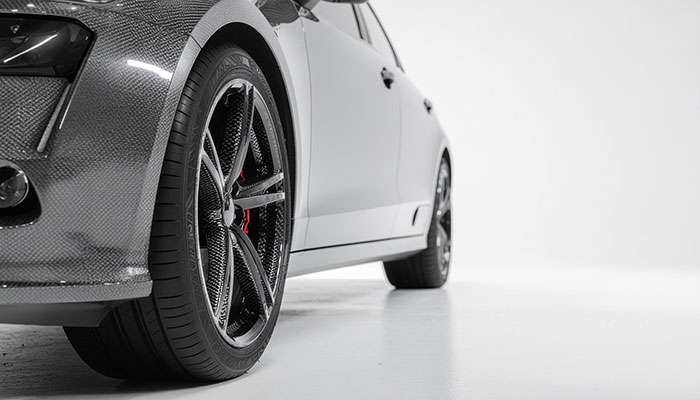
Picture this: what started as simple wooden disks in ancient Mesopotamia around 3500 BCE has become today's high-tech carbon fiber wheels that can shave seconds off your lap time. The story of wheel development spans over 5,000 years of human ingenuity, with each major breakthrough solving real problems that drivers and riders faced.
Think about the key moments that changed everything. Spoked designs appeared around 2000 BCE, making wheels lighter and easier to handle. Iron rims during the Iron Age gave wheels the durability they desperately needed. Then came Robert William Thomson's pneumatic tire invention in 1845[-3] - a game-changer that finally solved the bone-jarring ride quality issue. The 1950s and 1960s brought us lightweight alloy wheels that made vehicles handle better and go faster. Now we've got wheels made from aluminum, titanium, and carbon fiber that are both stronger and lighter than anything our ancestors could have imagined.
Here's what we'll cover: the complete story of how wheel design evolved from those first stone disks to today's cutting-edge carbon fiber technology. You'll discover the key innovations that didn't just change how wheels look, but completely altered how they perform and what they can do for your vehicle.
Here's something fascinating: wheels didn't start out moving people around at all. Potter's tools were actually the first application of this world-changing invention. Archaeological evidence from Mesopotamia shows the first wheel-like objects appeared around 3500 BCE. Those early versions were solid wooden disks made from several planks joined together—no nails needed since iron hadn't been discovered yet. The shift from pottery workshop to transportation happened slowly, with wheeled vehicles spreading across Europe and Asia between 3500-3350 BCE.
Ancient craftspeople knew what they were doing, even 5,500 years ago. Archaeologists in Zurich found solid disk wheels made from maple wood planks—smart choice for flexibility and toughness. These wheels had square axle holes, which meant the axles spun with the wheels instead of staying stationary. We know they caught on quickly because a Sumerian pictograph from Erech, dated around 3500 BCE, shows a sledge fitted with wheels. The Bronocice pot from Poland (3,635-3,370 BCE) gives us one of the earliest pictures of a four-wheeled vehicle.
Around 2000 BCE in Anatolia (today's Turkey), someone had a brilliant idea: why not make wheels lighter? Enter spoked wheels. This design used a central hub connected to the rim with thin rods or spokes. The benefits were immediate and obvious: much lighter weight, better shock absorption, and way easier repairs when something went wrong. The Sintashta people who developed this technology gained a real military edge through better mobility. We've found archaeological proof of these early spoked wheels in burial sites from 2100-1800 BCE.

Celtic chariots from 800-450 BCE brought the next big improvement: iron rims. These chariots used wooden spoked wheels, usually two-and-a-half to three feet across, wrapped with iron tires for serious durability. Celtic builders preferred sturdy ash wood and positioned wheels outside the chariot body for better stability and cornering on rough ground. The results speak for themselves—Celtic drivers could handle their chariots with incredible skill. Julius Caesar documented how they could "control the horses at full gallop, and check and turn them at a moment" even on steep slopes.
The industrial revolution changed wheel technology forever. While ancient wheels had done their job for thousands of years, the 1800s brought innovations that completely redefined what wheels could do and how they performed.
Celtic chariots around 1000 BCE were the first to get iron rims around their wooden wheels. The process was incredibly demanding - blacksmiths had to forge-weld short iron bars into a perfect hoop, heat it until it glowed red-hot, then hammer it onto the wooden wheel. After quenching the iron to make it shrink tight, you had a wheel that could actually handle rough terrain. Making just one inch-thick rim could burn through an entire oak tree's worth of charcoal. Those distinctive weld lines and hammer marks you can still see on archaeological finds? That's proof of the serious craftsmanship these wheels required.
Scottish inventor Robert William Thomson was only 23 when he patented the first pneumatic tire on December 10, 1845. He called it the "Aerial Wheel" and designed it specifically for carriages. Thomson's design used a rubberized fabric tube filled with pressurized air, wrapped in thick leather with the tread stitched right to the sidewalls. The ride quality improvement was dramatic, and his tires lasted over 1,200 miles before wearing out. But here's the catch - rubber cost so much that nobody could afford Thomson's invention, which killed its commercial prospects.
Veterinary surgeon John Boyd Dunlop solved the cost problem in 1887. Watching his 9-year-old son struggle with solid rubber wheels on his tricycle gave Dunlop the motivation he needed. He made a tube from sheet rubber, added a one-way valve, filled it with air, then wrapped it in Irish linen and nailed it to a wooden disk. After months of testing, Dunlop got his patent on December 7, 1888. His timing couldn't have been better - the cycling craze was just taking off, and within ten years, air-filled tires had basically replaced solid rubber ones everywhere.
Wire-spoked wheels solved a major engineering challenge: how to make wheels both stiff and light at the same time. George Cayley invented them back in 1808, but they weren't strong enough for cars until tangential spokes came along. Around 1907, they started showing up in automobiles, especially after John Pugh created detachable and interchangeable wheels for Rudge-Whitworth. The smart design used two inner rows of tangential spokes to handle braking and acceleration forces, plus an outer row of radial spokes for lateral strength when cornering.
The 1960s marked a turning point when aluminum alloy wheels changed everything about how vehicles performed and looked.
Alloy wheels solved a problem that had plagued drivers for decades - heavy steel wheels that hurt performance and limited design options. Made from combinations of metals like aluminum and magnesium, these new wheels offered serious weight savings over traditional steel models. The big automakers jumped on this technology fast: Cadillac rolled out their Saber-Spoke aluminum wheel, Pontiac created an aluminum integrated wheel with brake drum, and Ferrari started offering magnesium Cromodora Starburst wheels as alternatives to their classic wire-spoke designs. The weight reduction immediately improved handling and fuel efficiency, which made them especially popular in motorsports where every ounce matters.
Racing teams discovered that magnesium alloy wheels—commonly called "mags"—were the first die-cast wheels that could handle serious performance demands. The weight differences are dramatic: magnesium weighs 75% less than steel, 50% less than titanium, and 33% less than aluminum. While magnesium wheels stay popular in competitive motorsports because of these incredible weight savings, they're prone to corrosion which limits their use in daily drivers. You'll still find racing teams choosing magnesium wheels specifically to cut lap times, like the ones used on high-performance Porsche GT3 Cup cars.
Alloy wheels opened up a whole new world of customization that steel wheels simply couldn't match. Complex spoke patterns and unique finishes became possible. Two main manufacturing processes make this happen: casting involves pouring molten metal into molds, while forging presses solid metal under extreme pressure. Forged wheels cost more but they're stronger and lighter than cast versions. Custom wheel manufacturers now offer everything from specific center-bore measurements to bolt patterns, offsets, and distinctive finishes that let you personalize your ride.
Lighter alloy wheels make a real difference in how your vehicle performs by reducing unsprung weight. Studies show you can see a 2-5% improvement in fuel efficiency just by switching to alloy wheels. This happens because lighter wheels reduce rotational mass, so your engine doesn't work as hard during acceleration. Alloy wheels also dissipate heat better than steel ones, which means improved braking performance. The design matters for aerodynamics too - about 25% of your vehicle's aerodynamic drag comes from the wheels. Wheels with fewer spokes or flatter profiles create less air turbulence, giving you even better efficiency.

Wheel technology keeps pushing boundaries with materials and features that sound like science fiction but are available right now for your vehicle.
Carbon fiber wheels deliver serious performance gains that you can feel immediately. These wheels are 33% lighter than aluminum and 75% lighter than steel, which translates to better handling, quicker acceleration, and improved braking response through reduced unsprung weight. Ford started putting carbon fiber wheels on the Shelby Mustang GT350R back in 2015. General Motors discovered something impressive: carbon fiber wheels alone cut 1.5 seconds from a 2-minute lap time on the 2023 Corvette Z06. The manufacturing process is fascinating - thousands of carbon strands thinner than human hair get woven together, then high-grade resins are applied under precise temperature and pressure conditions.
Your wheels can now talk to you about their condition. SmartWheels technology captures what they call an "Electro-Tiro-Gram" with every rotation, tracking tread depth, temperature, and pressure in real-time. Continental's ContiSense technology takes a different approach, embedding sensors directly in conductive rubber layers to measure inflation pressure, tread depth, and spot punctures almost instantly. These smart systems warn you about potential problems before they become expensive headaches, helping prevent blowouts and unexpected downtime.
Flat tires might become a thing of the past. Michelin's X TWEEL design uses flexible spokes instead of compressed air to support your vehicle's weight, creating puncture-proof tires that last 2-3 times longer than traditional pneumatic versions. Goodyear's NexTrek airless tires have proven themselves at speeds up to 130 mph. Military testing in harsh environments like the Amazon rainforest shows these tires can keep running for hundreds of miles even when damaged.
3D printing opens up wheel customization possibilities we've never had before. Advanced resin materials now deliver exceptional strength and detail in 3D-printed wheels. You can get adjustable camber angles from 0° to 20° and professional airbrush finishes in whatever colors you want. This technology makes it possible to rapidly prototype and produce personalized wheel designs without the limitations of traditional manufacturing.
Environmental responsibility is driving real changes in how wheels get made. ALCAR recycles aluminum without any quality loss, using just one-tenth of the energy required for initial production. Steel wheel recycling cuts CO2 emissions by roughly 3,000 tons every year. Manufacturers are increasingly choosing electric steel and low carbon footprint aluminum to reduce their ecological impact. Future developments might include fully biodegradable wheel components and designs made entirely from renewable sources.
Looking back at this incredible journey, it's amazing how far we've come from those first wooden disks in Mesopotamia. Each major breakthrough solved real problems that people were facing - whether it was making wheels lighter with spokes, adding iron rims for better durability, or creating pneumatic tires for a smoother ride.
What really stands out is how each innovation built on the last one. Those ancient craftspeople who figured out spoked wheels around 2000 BCE set the stage for everything that followed. Thomson and Dunlop's pneumatic tire work finally gave us the comfort we needed. The industrial revolution made quality wheels available to more people through better manufacturing.
Then came the game-changers: aluminum alloy wheels in the mid-20th century that made vehicles handle better and use less fuel. Racing pushed things even further with magnesium and titanium options focused on cutting every possible ounce.
Today's carbon fiber wheels would blow the minds of those early wheelwrights - they're incredibly light yet stronger than anything we've had before. Smart wheels that monitor themselves in real-time? Airless tires that never go flat? These weren't even science fiction ideas just a few decades ago.
What's exciting about where we're headed is how 3D printing lets you get exactly the wheel setup you want, while sustainable materials help reduce environmental impact. The wheel manufacturers are really stepping up their game on both performance and responsibility.
This whole evolution shows something important: good solutions keep getting better when smart people focus on solving real problems. From those first wooden wheels to today's high-tech carbon fiber designs, it's been about making transportation work better for people. That drive to improve and innovate isn't stopping anytime soon - and that's great news for anyone who wants the best possible wheels for their ride.
The wheel's evolution spans over 5,500 years of continuous innovation, transforming from simple wooden disks to today's high-tech carbon fiber designs that revolutionize performance and efficiency.
• Ancient foundations matter: Mesopotamian solid wooden wheels (3500 BCE) and spoked designs (2000 BCE) established core principles still used today.
• Material breakthroughs drive performance: From iron rims to pneumatic tires (1845) to aluminum alloys (1960s), each material advancement dramatically improved durability and handling.
• Weight reduction equals better performance: Modern carbon fiber wheels are 75% lighter than steel, improving acceleration, braking, and fuel efficiency by up to 5%.
• Smart technology transforms functionality: Today's wheels feature embedded sensors for real-time monitoring and airless designs that eliminate flat tires entirely.
• Sustainability shapes the future: 3D printing enables custom designs while recycled materials reduce manufacturing's environmental impact by using 90% less energy.
The wheel's journey from ancient transportation tool to intelligent, lightweight marvel demonstrates how fundamental innovations continue evolving to meet changing human needs while pushing the boundaries of engineering possibility.
The wheel has undergone remarkable changes over millennia, evolving from simple wooden disks in Mesopotamia around 3500 BCE to today's high-tech carbon fiber designs. Key developments include the invention of spoked wheels around 2000 BCE, the addition of iron rims in the Iron Age, pneumatic tires in the 19th century, and lightweight alloy wheels in the mid-20th century.
Carbon fiber wheels offer significant benefits over traditional materials. They are approximately 33% lighter than aluminum and 75% lighter than steel wheels, which improves vehicle handling, acceleration, and braking performance. This weight reduction can also enhance fuel efficiency by up to 5% and even shave seconds off lap times in racing applications.
Smart wheels incorporate embedded sensors that monitor various parameters in real-time, such as tread depth, temperature, and tire pressure. These intelligent systems can alert drivers to potential issues before they become serious problems, helping to prevent blowouts and reduce maintenance costs. Some smart wheels can even detect punctures almost instantaneously.
Airless tires are a revolutionary design that eliminates the need for compressed air. Instead, they use flexible spokes or other structures to support the vehicle's weight. This makes them puncture-proof and potentially longer-lasting than traditional pneumatic tires. Companies like Michelin and Goodyear have developed airless tire technologies that have shown promising results in various testing environments.
Wheel manufacturers are adopting more sustainable practices to reduce their environmental impact. This includes recycling aluminum, which requires only one-tenth of the energy needed for initial production, and using electric steel and low carbon footprint aluminum. Some companies are exploring fully biodegradable wheel components and designs made from renewable sources. Additionally, 3D printing technology is enabling more efficient, customized production processes that can reduce waste.